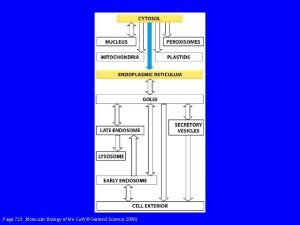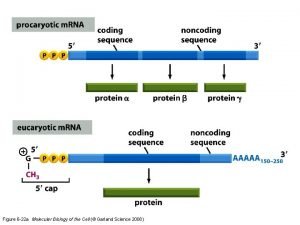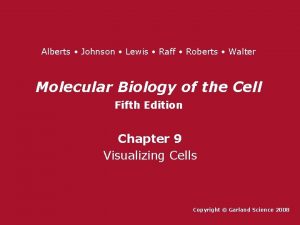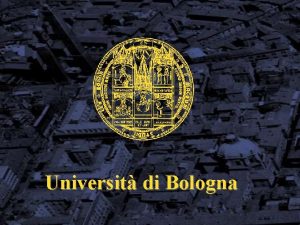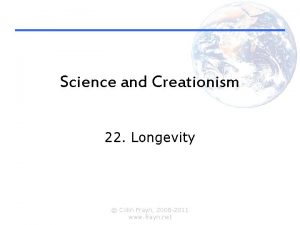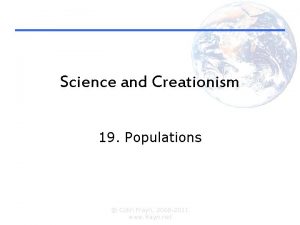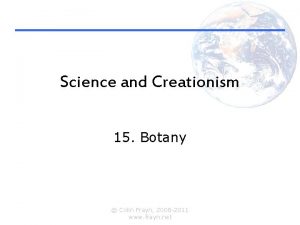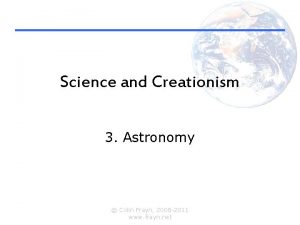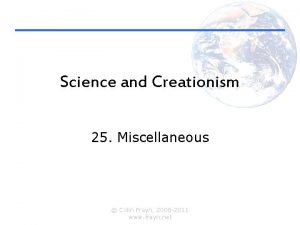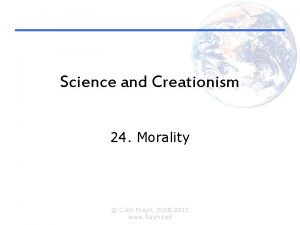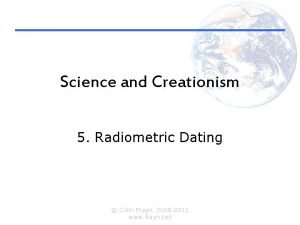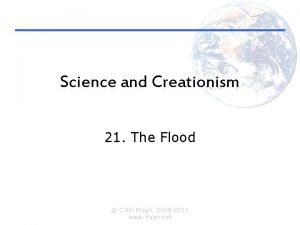Science and Creationism 16 Anatomy Colin Frayn 2008













- Slides: 13

Science and Creationism 16. Anatomy © Colin Frayn, 2008 -2011 www. frayn. net

Homologous structures • Homologous structures are those that appear similar in related species • Evolution predicts that certain organs, over a great deal of time, may change their function as a lineage evolves • Exaptation : The modification of use of an existing organ for a different function in a direct evolutionary descendant. • Do similar features merely propose the same designer? – No, because in most cases the best option for a designer would have been to completely redesign the organ from scratch rather than modify an existing organ to do something that it wasn’t originally ‘meant’ to do – Also, we have intermediate stages for many of these © Colin Frayn, 2008 -2011 www. frayn. net

Haeckel’s Embryos (1) Stages of development A copy (1892) of Ernst Haeckel’s original embryo sketches Different animals © Colin Frayn, 2008 -2011 www. frayn. net

Haeckel’s Embryos (2) • Haeckel faked some aspects of his original drawings – They are nowadays accepted as fraud • Some aspects were accurate and relevant – ‘Recapitulation theory’ – Many aspects of ontogeny (embryo growth) really do echo historical evolutionary stages • Whales have hair and leg bones • A structure resembling the tail of primates recedes to form the human coccyx bone • Swim bladder of fish develops first as a component of the gut, according to its presumed evolution, and then later detaches from the gut completely © Colin Frayn, 2008 -2011 www. frayn. net

Ontogeny recapitulates phylogeny • The ‘subtitle’ of Haeckel’s Recapitulation hypothesis • This theory suggests that embryological stages remind us of the evolutionary history of an organism • This is somewhat true, but is largely discredited in the sense that Haeckel intended it © Colin Frayn, 2008 -2011 www. frayn. net

Gill slits in embryos • Do human embryos have ‘gill slits’ reminiscent of their evolutionary history? • No, though they do have features that resemble gill slits called pharyngeal pouches – In humans, these features have nothing to do with breathing – All vertebrate embryos have these – In fish, these do develop into gills – Common features are strong evidence for common ancestry © Colin Frayn, 2008 -2011 www. frayn. net

Vestigial organs are supposed ‘remnants’ of evolutionary history that have not yet fully disappeared • Tiny leg bones in whales • The human appendix • Eye remnants in blind cave fish These may have minor functions, but certainly not the ‘obvious’ ones. They are remnants of a more prominent organ which has become redundant. © Colin Frayn, 2008 -2011 www. frayn. net

The Eye Is the eye too complicated to have evolved? • The eye could easily have evolved in under a million years – Nilsson & Pelger (1994) • Many different eye types exist in nature – The eye has evolved many times • Maybe from a very simple common ancestor organ • Maybe totally independently • The eye is evidence of poor design – The retinal cells are ‘plugged in’ backwards! – The contrary claims of Michael Denton and others are not plausible © Colin Frayn, 2008 -2011 www. frayn. net

Eye Anatomy Blind spot where the optic nerve crosses the retina © Colin Frayn, 2008 -2011 www. frayn. net

Inverted Retinal Cells Photoreceptive cells in the retina are plugged in backwards • This means that: – Less light gets to the photo receptors – We have a blind spot – We are susceptible to many more blinding diseases • Is this is actually a good design after all? –No, these arguments fail • ID arguments are flawed – An intelligent designer would have designed the eye differently – The eye is forced to solve problems that need not even exist – Squid have retinas wired “correctly” and they see very well • …and no, their eyes don’t overheat! © Colin Frayn, 2008 -2011 www. frayn. net

Darwin and Eye Evolution • Did Darwin write “To suppose that the eye … could have been formed by natural selection, seems, I freely confess, absurd in the highest possible degree”? • Yes, and he followed it with the words: “Yet reason tells me, that if numerous gradations from a perfect and complex eye to one very imperfect and simple, each grade being useful to its possessor, can be shown to exist; if further, the eye does vary ever so slightly, and the variations be inherited, which is certainly the case; and if any variation or modification in the organ be ever useful to an animal under changing conditions of life, then the difficulty of believing that a perfect and complex eye could be formed by natural selection, though insuperable by our imagination, can hardly be considered real. ” • And then he quoted several pages of suggested evolutionary models. © Colin Frayn, 2008 -2011 www. frayn. net

Irreducible Complexity • Structures that cannot work if any one of their parts is not present – There are many of these, but… • Structures may have had alternate uses before evolving to their current form • Bacterial flagellum – An ‘engine’ for bacteria – A plausible evolutionary model exists – Lots of work has been done in this area • Immune system cascade – This poses no problem whatsoever – Models to explain the origin of chemical pathways are abundant © Colin Frayn, 2008 -2011 www. frayn. net

Behe at Dover • In the trial of Kitzmiller vs. Dover Area School District (2005), Michael Behe testified that several irreducibly complex systems exist. Quotes from Judge Jones’s ruling: “As expert testimony revealed, the qualification on what is meant by ‘irreducible complexity’ renders it meaningless as a criticism of evolution. In fact, theory of evolution proffers exaptation as a well-recognized, well-documented explanation for how systems with multiple parts could have evolved through natural means. ” “We therefore find that Professor Behe’s claim for irreducible complexity has been refuted in peer-reviewed research papers and has been rejected by the scientific community at large. ” “. . . on cross-examination, Professor Behe was questioned concerning his 1996 claim that science would never find an evolutionary explanation for the immune system. He was presented with fifty-eight peer-reviewed publications, nine books, and several immunology textbook chapters about the evolution of the immune system; however, he simply insisted that this was still not sufficient evidence of evolution, and that it was not ‘good enough. ’” © Colin Frayn, 2008 -2011 www. frayn. net
 Michael frayn spies
Michael frayn spies David plaisted creationism
David plaisted creationism 2008 2008
2008 2008 Why science is my favourite subject
Why science is my favourite subject Cardiolipina
Cardiolipina Guanilil transferasi
Guanilil transferasi Garland science 2008
Garland science 2008 Science olympiad anatomy and physiology
Science olympiad anatomy and physiology Science olympiad anatomy and physiology 2020 cheat sheet
Science olympiad anatomy and physiology 2020 cheat sheet Alice chen md
Alice chen md Cilta unibo
Cilta unibo Colin took a sample of 80 football players
Colin took a sample of 80 football players Im sorry john
Im sorry john Colin poem
Colin poem




